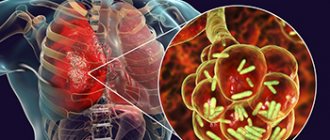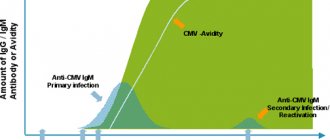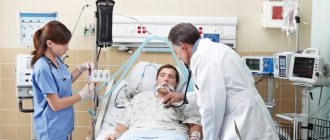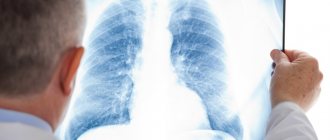Pneumonia is an inflammation of the lungs caused by one or another infectious agent - a virus: coronavirus, adenovirus, etc.
Pathogenic microorganisms enter the human body through airborne droplets or household contact. If a viral infection easily penetrates through the respiratory tract to the lung parenchyma, and the human immune system cannot resist it, an inflammatory process begins, sometimes with complications (pleural effusion, abscess formation, pulmonary fibrosis).
The causative agent of pneumonia can be:
- Adenovirus;
- Respiratory syncytial virus;
- Pseudomonas aeruginosa;
- Herpesvirus;
- Cytomegalovirus;
- Enterovirus;
- Epstein-Barr virus;
- Parainfluenza virus;
- Measles virus;
- Influenza viruses type A and B;
- Coronaviruses (SARS-CoV, SARS-CoV2, MERS-CoV);
- Streptococcus pneumoniae;
- Haemophilus influenzae (Afanasyev-Pfeiffer bacillus);
- Escherichia coli;
- Mycoplasma pneumoniae and others.
Etiology of pneumonia
Such respiratory infections behave differently in the human body: some affect the alveoli and interstitium, others - bronchioles; in some cases, viruses provoke pneumonia “lightning fast”, within several days, in others - gradually, “descending” through the nasopharynx , trachea and bronchi, causing pneumonia only after a month. Finally, infections prefer different segments of the lungs for localization, and sometimes spread chaotically and diffusely.
Thus, for each viral pneumonia, depending on the type of pathogen, a typical pattern is characteristic. Sometimes, just by one “pattern” of pneumonia on CT scans it is possible to distinguish, for example, adenoviral pneumonia from respiratory syncytial virus. To clarify the type of infectious pathogen, the patient is prescribed a laboratory test (analysis of nasopharyngeal discharge, PCR, immunoglobulin test, etc.).
Viral pneumonia is usually accompanied by a sharp deterioration in health, high fever, symptoms of acute respiratory disease (cough, difficulty breathing), and intoxication of the body. However, there are cases where community-acquired pneumonia at an early stage developed without pronounced symptoms, which are difficult to distinguish from ARVI.
The mechanism of development of viral pneumonia is as follows: the virus penetrates alveolocytes (lung cells), attaches itself to them and begins to multiply. As a result, the cells die. In response to blood infection by a virus, leukocytes and lymphocytes - the body's protective cells - release cytokines. However, this leads to the accumulation of liquid exudate in the alveoli, causing the lung tissue to swell and making it difficult for a person to breathe because the number of functional alveoli - small cells in which oxygen is stored - is reduced.
Atypical pneumonia is an inflammation of the lungs caused by a previously unknown and undetectable pathogen, while the clinical manifestations of the disease are unusual and do not lend themselves to known medical classification.
Young children and patients with immunodeficiency are especially susceptible to viral pneumonia, since the body of such patients does not have enough protective resources (antibodies). More than 90% of all pneumonia in children is a viral infection of the lungs.
Advantages of SM-Clinic
The children's department of our medical center employs some of the best pediatricians, pulmonologists and other specialists in the Northern capital.
Make an appointment at the first sign of a respiratory disease or its complications - we will help quickly and effectively.
If a child has a severe form of pneumonia and requires hospitalization, we will offer a comfortable and cozy room. The patient will be monitored around the clock by responsible medical personnel, and effective therapy will be provided.
Sources:
- T.A. Kovtun, A.V. Tutelyan, S.V. Shabalina. Features of the course of pneumonia in children and principles of therapy // Epidemiology and infectious diseases, 2012, No. 3, pp. 52-56.
- L.S. Namazova-Baranova, T.V. Kulichenko, A.E. Malakhova, E.V. Starovoitova, M.D. Bakradze, I.L. Chashchina, I.L. Mityushin. Pneumococcal pneumonia in children: lessons from everyday practice // Issues of modern pediatrics, 2012, vol. 11, no. 4, pp. 65-72.
- https://www.ncbi.nlm.nih.gov/pubmed/31518547 Nascimento-Carvalho C.M. Community-acquired pneumonia among children: the latest evidence for an updated management // J Pediatr (Rio J). 2021 Sep 10. pii: S0021-7557(19)30493-0. doi: 10.1016/j.jped.2019.08.003.
Symptoms of viral pneumonia
Depending on the type of pathogen (type of pneumonia), the disease develops differently. For example, the adenovirus has an acute onset - high fever, conjunctivitis, severe sore throat and prolonged rhinitis, during which it is impossible to breathe through the nose.
Pneumonia associated with coronavirus develops gradually - at first the patient is only concerned about low temperature (37-38 degrees) and weakness. However, the temperature lasts a long time, and on the 5th-6th day obvious shortness of breath, chest pain, and dry cough may appear, indicating lung damage.
Inflammation of the lungs, which occurs against the background of ordinary flu, is severe. The disease begins with high fever (up to 40 degrees), chills, fog, and pain throughout the body. The patient is bothered by respiratory symptoms (cough and runny nose), but they are not very intense. Sometimes the virus affects the mucous membrane of the eyes (conjunctivitis). The patient gets better occasionally, but in a short period of time the state of health can deteriorate sharply. The patient's critical condition is indicated by bluish skin, increased cough and shortness of breath, pain and decreased blood pressure.
The most common, general signs of viral pneumonia include:
- Heat;
- Symptoms of acute respiratory disease: cough, shortness of breath, shortness of breath;
- Weakness, bone aches, muscle pain and headaches;
- Chest pain or discomfort;
- Disruption of other organs and systems: gastrointestinal disorder, conjunctivitis, pressure surges.
If a viral infection of the lungs is suspected, blood oxygen saturation is measured using a pulse oximeter. If the rate is below 95%, the patient needs medical attention. Normally, the percentage of blood oxygen saturation = 100 or close to this figure.
Pneumonia in children: symptoms, treatment, prevention
Thursday, December 13, 2018
Pneumonia (pneumonia) is a serious infectious disease that affects people of all ages. And children are no exception. Recently, there has been an increase in the number of acute infectious diseases of the respiratory system, and pneumonia is the most dangerous of them. Therefore, parents should understand what pneumonia is, how to recognize this disease, and what to do if it appears in a child.
Description
The danger of the disease is associated with the important role played by the lungs in the human body. After all, the lungs perform the function of delivering oxygen to the tissues of the body and, therefore, damage to such an important organ can have serious consequences.
The lungs receive oxygen from the upper respiratory tract during inhalation. In the special vesicles of the lungs - the alveoli - the process of enriching the blood with oxygen occurs. At the same time, carbon dioxide enters the alveoli from the blood and is released out during exhalation. The inner surface of the lungs has a mucous membrane, the purpose of which is to protect the lungs from negative external influences.
Each lung consists of 10 segments, which are grouped into lobes - there are three in the right lung, two in the left. With pneumonia, the infectious process affects the internal structures of the lungs, which significantly complicates the process of breathing and gas exchange. And this can affect other organs, primarily the heart.
Gas exchange does not exhaust the functions of the lungs in the body. They also participate in the following processes:
- regulation of body temperature,
- filtration of harmful substances,
- regulation of the amount of liquids and salts,
- blood purification,
- removal of toxins,
- synthesis and neutralization of proteins and fats.
With infectious diseases of the gastrointestinal tract, poisoning, injuries and burns, the load on the lungs increases many times, and they may not be able to cope with removing toxins from the body. This can provoke an infectious process in the lungs.
Types of pneumonia
Unlike other respiratory diseases, the proportion of cases with a purely viral etiology is small. In approximately 80% of cases, we are talking about damage to the lungs by various strains of bacteria. In childhood, the bulk of pneumonia is associated with three types of bacteria - pneumococcus, mycoplasma and pulmonary chlamydia. However, other types of bacteria can also become a source of disease.
These include staphylococci, streptococci, Klebsiella, Haemophilus influenzae, Escherichia coli, Pseudomonas aeruginosa, Mycobacterium tuberculosis and some others. Much less often, the lungs suffer from the effects of pathogenic fungi; even less often, pneumonia caused by helminths can occur.
Pathogens are also distributed unevenly across age groups. Pneumonia in infants and preschool children is most often caused by pneumococci. At primary school age, children are more often susceptible to mycoplasma pneumonia. Teenagers most often suffer from pneumonia caused by chlamydia.
Based on the size and shape of the area of inflammation, pneumonia is divided into:
- focal,
- segmental,
- drain,
- lobar,
- left-handed,
- right-sided
With focal pneumonia, there are only individual foci of inflammation about 1 cm in size, and with confluent pneumonia, these foci merge together. In segmental pneumonia, one segment of the lungs is affected. With the lobar type of pneumonia, the pathological process covers the entire lobe.
With bronchopneumonia, not only the lung tissue is affected, but also the bronchial mucosa. Usually bronchopneumonia is a consequence of bronchitis.
Pure viral pneumonia is less common. The causative agents of this form of the disease can be influenza viruses, parainfluenza, and adenoviruses. Bilateral pneumonia is most often caused by pneumococci and Haemophilus influenzae. Atypical pneumonia in a child is most often caused by mycoplasmas and chlamydia. This type of pneumonia can last longer and is difficult to treat with antibiotics.
Hospital-acquired pneumonia is most often caused by staphylococci, Pseudomonas aeruginosa and Klebsiella.
Features of pneumonia in childhood
Left-sided pneumonia in a child is most often more severe than right-sided pneumonia. This is due to the fact that the lungs have an asymmetrical structure, and the airways on the left side are narrower than on the right. This circumstance makes it difficult to remove mucus and contributes to the establishment of infection.
It is well known that children are more susceptible to pneumonia than adults. There are several reasons for this fact. First of all, young children have rather weak immunity compared to adults. And the second reason is that a child’s respiratory organs are not as developed as those of an adult. In addition, the narrowness of the respiratory passages in children causes mucus to stagnate in them and makes it difficult to remove.
Also, in infants, breathing is usually carried out using movements of the diaphragm, which are influenced by the state of the gastrointestinal tract. Disruption of its functioning, expressed, for example, in bloating, immediately affects the lungs - stagnation occurs in them, leading to an increase in the number of pathogenic microorganisms. Infants also have relatively weak respiratory muscles, which prevent them from coughing up mucus effectively.
Symptoms of pneumonia in a child
How does pneumonia manifest? Symptoms of pneumonia in children of different ages are slightly different. However, it is worth noting that with all types of pneumonia, a symptom such as respiratory failure is noted. It is expressed, first of all, in increased breathing during pneumonia, which usually does not happen with infectious diseases of the upper respiratory tract. Normally, the ratio of pulse and respiratory rate is 3 to 1. However, with pneumonia, the ratio can reach 2 to 1 and 1 to 1. That is, if a child’s pulse is 100, then the respiratory rate can be more than 50 breaths per minute. Despite the increased frequency of breathing, it is usually superficial and shallow.
How else can you determine respiratory failure? There are a number of other signs that indicate it, for example, blue discoloration of the skin surfaces, primarily in the area of the nasolabial triangle. Sometimes pale skin may occur.
Secondly, with pneumonia there is another characteristic sign - high temperature. The level of hyperthermia in pneumonia is usually much higher than in other respiratory diseases and can reach +39-40ºС. However, this symptom may not occur with all types of pneumonia. Signs of atypical pneumonia in a child include low-grade fever or a temperature slightly above +38ºC. Sometimes a disease scenario can be observed when the temperature rises to high values in the first days and then decreases. In addition, in children under one year old, due to the imperfection of the immune system, the temperature can also remain within the subfebrile range even with the most severe forms of pneumonia.
Signs of pneumonia in a child include other respiratory symptoms. First of all, it's a cough. As a rule, it can be observed if the infection affects not only the lungs, but also the bronchi, which most often happens in practice, and also if pneumonia is a complication of acute respiratory infections. The cough can be varied, but as a rule, it is not completely dry, but is associated with the discharge of sputum. Or, in the first days of the disease, a dry cough appears, and then it turns into a cough with expectoration of sputum. Bilateral lobar pneumonia is characterized by a variety of manifestations. In children, symptoms of this form of the disease include not only a cough, but “rusty” sputum, including red blood cells from damaged small capillaries.
When pneumonia develops in a child, symptoms will include signs of intoxication - headaches, nausea, dizziness. With some types of pneumonia in children, symptoms may include pain in the chest, sometimes in the hypochondrium.
Symptoms of pneumonia in an infant may not be as severe as in older children. Often, symptoms of pneumonia in infants include only low-grade fever and cough (in some cases, it may not be present). Therefore, recognizing the disease before the age of one year is difficult. You should pay attention to indirect symptoms - low muscle tone, lethargy, breast refusal, anxiety, frequent regurgitation.
Causes
Based on the causes of occurrence, pneumonia is divided into primary and secondary. Primary pneumonia includes cases of disease that arise directly from infection with pathogens. Secondary pneumonia includes cases of disease that are complications of other respiratory diseases - ARVI, bronchitis, influenza, sore throat, etc.
In most cases we are talking about secondary diseases. It should be noted that viral respiratory diseases very often provoke the occurrence of pneumonia and prepare the ground for them by weakening the immune system and reducing the protective properties of the bactericidal sputum formed in the lungs.
Quite rarely, pneumonia is transmitted from person to person by airborne droplets. As a rule, the causative agents of the disease already live in the body, long before it begins, and are simply waiting in the wings to begin their attack on the lungs. A trigger that can provoke the activation of pathogenic microflora can be an infectious disease of the upper respiratory tract, influenza, weakened immunity, for example, as a result of hypothermia.
A special group of cases of pneumonia includes so-called hospital infections. They occur in hospitals when patients are being treated for other diseases. Hospital-acquired pneumonia is caused by special, hospital-acquired strains of bacteria that are highly resistant to traditional antibiotics.
Thus, pneumonia can also be caused by congestion in the lungs associated with prolonged bed rest. In young children, congestion in the lungs can also be caused by intestinal infectious diseases, in which bloating appears and normal ventilation of the lungs is disrupted. Also, the occurrence of pneumonia can be facilitated by frequent regurgitation of food by a child, during which vomit containing intestinal pathogenic microorganisms can partially enter the lungs.
If pneumonia occurs in newborns, then there can be two main reasons for this - either the child became infected directly in the maternity hospital, or was infected already in the womb.
Other factors contributing to the disease:
- stress,
- avitaminosis,
- unhealthy diet
- passive smoking of others.
Diagnostics
Acute pneumonia in a child can only be diagnosed by a doctor. At the first signs of pneumonia in a child, you should call a therapist. An experienced doctor can determine the source of inflammation by listening to noises and wheezing in the lungs and tapping the chest. Other diagnostic signs are also used to recognize the disease: respiratory failure, the nature of hyperthermia, damage to the upper respiratory tract.
However, in order to unambiguously make a diagnosis and determine the location of the source of the disease, radiography is required in most cases. The x-ray image clearly shows the extent of lung damage and the area of distribution of the pathological process. It is this sign that is most important in diagnosis.
However, x-rays do not always allow one to determine the causative agent of the disease. But the treatment strategy largely depends on this information. For this purpose, bacteriological analyzes are used - the isolation of antibodies to the pathogen or the pathogens themselves from the blood and droplets of sputum. True, it is not always possible to unambiguously determine the pathogen, since sputum may contain several potentially pathogenic microorganisms at once. In addition, a violation of the leukocyte formula, an increase in the level of ESR (20 mm/h or more), and a decrease in hemoglobin are taken into account. However, a significant increase in the number of leukocytes does not accompany all types of pneumonia. The maximum increase in the number of leukocytes is observed during chlamydial infections (30,000 per μl).
Forecast
In most cases of pneumonia in children, provided timely consultation with a doctor, the prognosis is favorable. Pneumonia poses a serious threat to life in newborns and infants, especially premature infants. Also dangerous for their severe complications are pneumonia caused by staphylococci and streptococci, as well as Pseudomonas aeruginosa. In most cases, with proper treatment, the likelihood of complications is low.
Complications
Pneumonia in a child aged 2 years can take severe forms and spread to other organs.
Among the most common complications are lung abscess, destruction of lung tissue, pleurisy, and air entering the pleural area.
Complications of pneumonia in children that affect other organs:
- heart failure,
- sepsis and septic shock,
- meningitis,
- myocarditis,
- endocarditis,
- pericarditis,
- blood clotting disorder.
Treatment
Treatment of acute pneumonia in a child can be carried out both in a hospital and at home. The choice of one or another option is made by the doctor, based on the following factors:
- child's age,
- patient status,
- suspected type of disease
- the ability of parents to provide adequate care for the child,
- presence of smokers in the family.
If acute pneumonia is not treated, it can become chronic, lasting up to six months.
Treatment of bacterial pneumonia in a child is carried out mainly with antibiotics. Of course, during the first examination, the doctor often does not have the opportunity to accurately determine the type of pathogen. Therefore, general antibiotics are prescribed first, or an antibiotic is selected based on rough assumptions. Subsequently, as diagnostic data accumulates, this assignment can either be canceled or confirmed. The effectiveness of the antibiotic is assessed in the first days after prescription, usually after 2-3 days. How can you tell if the drug has worked? If, while taking it, the patient’s condition improves - a decrease in temperature, a weakening of symptoms indicating pulmonary failure, then drug therapy with this drug continues. If there is no improvement, then another drug is used. By this time, the doctor may already have information about the nature of the infection that can help him make the right choice.
Not every antibacterial drug can be used to treat pneumonia in children. Among the drugs that are effective against pneumonia and approved in pediatric practice, the most widely used antibiotics are cephalosporins and macrolides. However, the choice of other drugs is also possible - penicillins, sulfonamides, amoxicillins. Fluoroquinolones and tetracyclines are used less frequently, only in cases of severe complications and the ineffectiveness of other agents. It is also worth taking into account the age of the child, for example, at 3 years old some drugs may be suitable, but at 1 year old – no longer.
Choosing a drug is not an easy task, and it should not be done at random, by people who do not have information about the properties of antibiotics, but by a qualified specialist with extensive practical experience and able to take into account all factors, such as contraindications, effectiveness and side effects of the drug, as well as the patient’s condition , his age, characteristics of the disease. Otherwise, the use of antibiotics can only cause harm.
If a child has pneumonia, oral antibiotics are usually prescribed. However, if the disease is severe, or if taking antibiotics causes nausea or vomiting in the child, parenteral administration of the drugs is prescribed.
You should strictly follow the dosage of medications prescribed by your doctor. Irregular use can negate the entire therapeutic effect of the medication, due to the fact that there will not be a sufficient concentration of the substance in the blood. Also, if the patient shows signs of improvement, you should not stop taking the drug; you must complete the course of treatment.
Among the negative factors associated with taking antibiotics, one should highlight the fact that they negatively affect the beneficial microflora of the body, primarily the intestinal one. Therefore, in parallel with taking antibiotics, probiotics should also be taken.
Should I use antipyretic and anti-inflammatory drugs for pneumonia in a child? This can be done in some cases, but only with the permission of a doctor. Reducing the temperature with the help of antipyretics for pneumonia is not recommended for the reason that hyperthermia is a protective reaction of the body and is designed to mobilize all its forces to fight the infection. Of course, a lot depends on how high the temperature is. If it exceeds +39ºС, then such overheating of the body can negatively affect the patient’s condition. In young children, high fever can even lead to seizures. In such cases, it is worth giving the child an antipyretic when the thermometer reaches +37.5ºС. Otherwise, if the child tolerates the temperature well and does not have any concomitant diseases in which a high temperature can be dangerous, then it is better not to lower the temperature artificially. Paracetamol and other non-steroidal drugs are most often used as antipyretic drugs.
It is also necessary to give the patient as much fluid as possible. When a child has pneumonia, the body loses a lot of fluid - this is due, first of all, to excessive sweating. In addition, drinking plenty of fluids allows you to quickly remove toxins from the body. However, if there are signs of pulmonary edema, fluid intake is limited.
As a rule, pneumonia in a child is combined with the formation of mucus in the bronchi and a cough, during which this mucus is removed from the respiratory system. Therefore, cough relief drugs are an important category of drugs. They are divided into three main groups - mucolytic, expectorant and bronchodilator. Mucolytics reduce the viscosity of bronchial mucus, and expectorants facilitate its removal. Among expectorants and mucolytic drugs, bromhexine, ambrohexal, and acetylcysteine are most often used. Among bronchodilators intended to relieve bronchospasms, aminophylline is most often used.
Antitussive drugs that suppress the activity of the cough center are contraindicated because they lead to stagnation of sputum in the lungs.
Is it possible to use folk remedies?
Is it worth using traditional medicine for pneumonia diagnosed in a child, and can they replace antibiotics? As you know, many parents are wary of antibiotics. And this concern is understandable - after all, antibiotics can have side effects, for example, dysbiosis and can cause allergic reactions. Therefore, they are trying to replace antibiotics in the treatment of infectious diseases with some alternative means. It is worth saying directly that such an approach in the case of bacterial pneumonia is irresponsible frivolity.
Pneumonia in a child is not a sore throat, which goes away in seven days if treated, and in a week if untreated. It is a serious and life-threatening disease with no effective treatment other than antibiotics. This is due to the fact that the source of inflammation is located very deep, sometimes in the lower part of the lungs, and no amount of gargling with herbal infusions or even inhalation can affect it. Those wishing to treat their child with traditional methods should remember that before the invention of antibiotics, the survival rate of young children in case of pneumonia was about 30%. These statistics clearly show the effectiveness of folk remedies compared to modern antibiotic therapy. Of course, if a child does not tolerate an antibiotic well, then you should tell the doctor about it, and he will probably be able to find a replacement.
Additional measures during treatment
Massage and physiotherapy may be prescribed as auxiliary measures. They are carried out for pneumonia, when the child’s temperature begins to decrease.
It goes without saying that when treating at home, the patient must remain in bed. The air in the room where it is located should not be too warm or too cold. The optimal temperature is 19-20 degrees. You should also ensure that there is sufficient air humidity, since dry air irritates the mucous membranes of the respiratory tract. In addition to drinking plenty of fluids, you should also pay attention to your diet. Of course, the patient should not be force-fed if there is no appetite at a high temperature. However, it is worth noting that when sick, the body must receive an increased amount of proteins, vitamins and microelements, so nutrition must be complete. Food should be easily digestible and hypoallergenic.
In inpatient conditions, in severe cases, oxygen therapy (artificial ventilation) is performed.
Recovery period
If all doctor's instructions are correctly followed, complete recovery can occur in 10-14 days. However, even after recovery, a child attending school should be exempt from physical education and physical activity for several months (from 1.5 to 3). Emotional and physical fatigue of children who have had pneumonia should be avoided. They are registered at the dispensary for a period of up to one and a half years. At this time, additional tests and x-rays may be prescribed. During the rehabilitation period, it is recommended to use breathing exercises.
After recovery, residual symptoms of the disease may be observed for some time, for example, a dry cough associated with insufficient restoration of the mucous membrane. To quickly restore lung functionality, sanatorium treatment and inhalation of sea air are recommended.
Prevention
Pneumonia in a child in most cases is a disease of reduced immunity. Therefore, prevention of the disease in children includes measures to increase immunity - hardening, proper daily routine, physical activity, good nutrition, taking vitamin complexes. At the same time, care should be taken to ensure that the child does not suffer from hypothermia, and that the air in the apartment is clean and has sufficient humidity. And, of course, it is necessary to promptly treat respiratory diseases that can become a direct cause of pneumonia - ARVI, pharyngitis, laryngitis, tonsillitis, and, first of all, bronchitis.
An important preventive measure is vaccination of children. There are no universal vaccinations against pneumonia at the moment, but you can get vaccinated against some pathogens of pneumonia, for example, pneumococcus and Haemophilus influenzae. Vaccinations against pneumococcal infection are included in the National Calendar of Preventive Vaccinations and are mandatory, given to children under 1 year of age twice with an interval of 2 months, vaccinations against Haemophilus influenzae are given to children at risk three times simultaneously with vaccination against diphtheria, whooping cough and tetanus at 3, 4.5 and 6 months and a single revaccination in the second year of life.
Polysegmental viral pneumonia
If a CT scan reveals that inflammatory foci and infiltrates are present not in one segment of the lung, but in several, such pneumonia is called polysegmental.
More about polysegmental pneumonia
The lungs are usually visually divided into 21 segments - 11 on the right side and 10 on the left side. Bilateral pneumonia of viral origin is the most common. For example, “ground glass” in coronavirus pneumonia is usually localized symmetrically on both sides around the bronchi or in the lateral parts of the lungs. In Pneumocystis pneumonia and influenza pneumonia, they are diffusely located on both sides.
Diagnostics
To classify the type of pneumonia and prescribe the correct treatment, it is necessary to identify the causative agent. 85% of successful diagnosis is the correct comparison of LBC culture and X-ray results.
Diagnostic procedures:
- Listening to the lungs with a stethoscope. Allows you to identify wheezing, “crackling” and “bubbling”.
- X-ray, CT or MRI of the chest. Compared to x-ray diagnostics, CT and MRI devices are more sensitive, the image has high resolution and detail, and it is possible to study in a complex projection.
- Collection of pleural fluid (exudate) for bacteriological examination or thoracentesis.
- Bronchoscopy. A visual examination of the respiratory tract also involves collecting material for analysis.
- Puncture biopsy of lung material for histological examination.
- PCR is a blood or sputum test for the pathogen.
- ESR/ROE, general blood test.
- Pulse oximetry is a measurement of blood oxygen saturation.
Based on your medical history, physical examination, and test results, your doctor may diagnose pneumonia. In cases of atypical pneumonia or inaccurate diagnosis, consultation with a pulmonologist may be required.
Viral pneumonia COVID-19
All known coronaviruses are characterized by rapid (up to 14 days) development of acute respiratory failure. The virus quickly and aggressively infects the lungs, causing not only extensive inflammation, but also associated complications: swelling of the respiratory organ, fibrosis (scarring of the lungs), acute heart failure, myocarditis.
The first coronavirus type B (SARS-CoV) was reported in 2002 and its primary hosts are believed to be horseshoe bats. In 2012, the world was gripped by an epidemic of coronavirus type C MERS-CoV (Middle East respiratory syndrome). Finally, in 2019, there was an outbreak of the new coronavirus type B COVID-19 (or SARS-Cov2). What they have in common is that new viruses are stable, easily attach to the lung parenchyma with protein spikes, and in a short time provoke extensive acute inflammation. The fatality rate is about 10%.
However, pneumonia is not always the cause of death from these viruses. For example, if the patient's medical history is complicated by atherosclerosis or myocarditis, the virus primarily affects the cardiovascular system. In general, the coronavirus family includes about 46 types of virions.
Read more about pneumonia associated with COVID-19 in our articleWhat does a CT scan of the lungs show for coronavirus?
Methods for effective prevention
Proper prevention does not include drug therapy. To prevent the disease you need:
- vaccinate your child in a timely manner;
- provide hardening, introduce physical education;
- breastfeed the baby in the first six months of life;
- do not smoke near the child;
- purify the air in the apartment;
- Consult a doctor in a timely manner if signs of unwellness occur. Source: https://www.ncbi.nlm.nih.gov/pubmed/31518547 Nascimento-Carvalho CM Community-acquired pneumonia among children: the latest evidence for an updated management // J Pediatr ( Rio J). 2019 Sep 10. pii: S0021-7557(19)30493-0. doi: 10.1016/j.jped.2019.08.003
Should I give my child antibiotics to prevent pneumonia?
If you find signs of ARVI in a child, then you should not give him antibiotics in advance, “for prevention.” Especially if you are going to do it yourself or on the recommendation of a pharmacist from your nearest pharmacy. According to the latest data, this measure will not only fail, but will also increase the likelihood of pneumonia for your child by almost 10 times.
Lung damage due to viral pneumonia
Lung infiltration in viral pneumonia on 3D reconstruction of the respiratory tract (CT-3)
For comparison, this is what normal lungs look like
Ground glass symptom (infiltrates) in viral pneumonia on cross-sectional CT scans
Coronavirus stages: CT-1, CT-2, CT-3, CT-4
Pulmonary fibrosis
Viral-bacterial pneumonia
In some cases, viral pneumonia is complicated by the addition of a secondary bacterial infection. This happens, for example, with respiratory syncytial virus and coronavirus (manifests on days 6-7 and is accompanied by more pronounced swelling of the lung tissue). Treatment of viral-bacterial pneumonia is carried out using a course of antibiotics, which are selected only after accurately determining the type of bacterial infection.
Reasons for the development of the disease
70-90% of clinical cases of the inflammatory process are infections with pathogenic microorganisms. Microorganisms actively grow in a short time, creating several internal layers, which complicates the treatment process. Antibacterial therapy eliminates the external staphylococcal conglomerate, leaving the internal one intact.
Pathogens enter the body through the upper respiratory tract, fix on the epithelium of bronchioles and multiply.
Infections that cause the disease:
- Bacterial: pneumococci, streptococci, Staphylococcus aureus, chlamydia, Haemophilus influenzae, Legionella, mycoplasma, herpetic agents types 1-6. Some bacteria are part of the opportunistic flora of the human body and provoke disease only when immunity is reduced. The rest enter the body in several ways: airborne (saliva, mucus of the patient), household (contact through a handshake, kiss), sexual (oral and genital contact), descending, when a child becomes infected from the mother through the birth canal, intrauterine - through the placenta .
- Fungal.
- Viral. According to the form, acute, abortive, latent, chronic or persistent pathology is distinguished.
- Parasites.
There is a direct relationship between the severity of pneumonia and immunity: the weaker the immune response, the more severely the lower respiratory tract is affected. This happens for a number of reasons:
- Excessive physical activity and constant stress increase the production of the adrenal hormones cortisol, norepinephrine, and adrenaline, which in turn inhibit the production of T-leukocytes and white blood cells.
- Smoking and alcohol provoke stenosis - a persistent decrease in the lumen of large and small vessels. The speed of lymph and blood flow decreases, making it difficult for leukocytes to work. Along with this, stable intoxication of the body occurs. The permissible harmless dose of alcohol is 30-50 ml.
- Thermal, chemical damage to the lungs when working in hazardous industrial production.
- Hypothermia.
- Congenital pathologies.
- Severe allergic reactions.
- Sedentary lifestyle. At risk are bedridden elderly people who are unable to take daily walks in the air, thereby triggering natural ventilation of the lungs.
Polysegmental pneumonia can be classified into several types:
- depending on the pathogen - typical/atypical,
- according to the localization of the inflammatory process - right-sided/left-sided or bilateral,
- according to the form of the disease - community-acquired/hospital-acquired,
- downstream - acute/protracted.
The community-acquired form is easily and quickly treatable; pathogen strains do not have pronounced resistance to antimicrobial therapy.
The hospital form develops when, against the background of the underlying disease, hospital microorganisms are added (infection from medical staff or a roommate). This form does not respond well to treatment, since the microorganism arose directly in a hospital setting and its defense mechanisms are strong.
Left-sided polysegmental pneumonia, unlike the right-sided one, is more dangerous due to the proximity of the inflammatory infiltrate to the heart muscle and large blood vessels. For this reason, the left-sided form of the disease is treated in an inpatient hospital setting.











